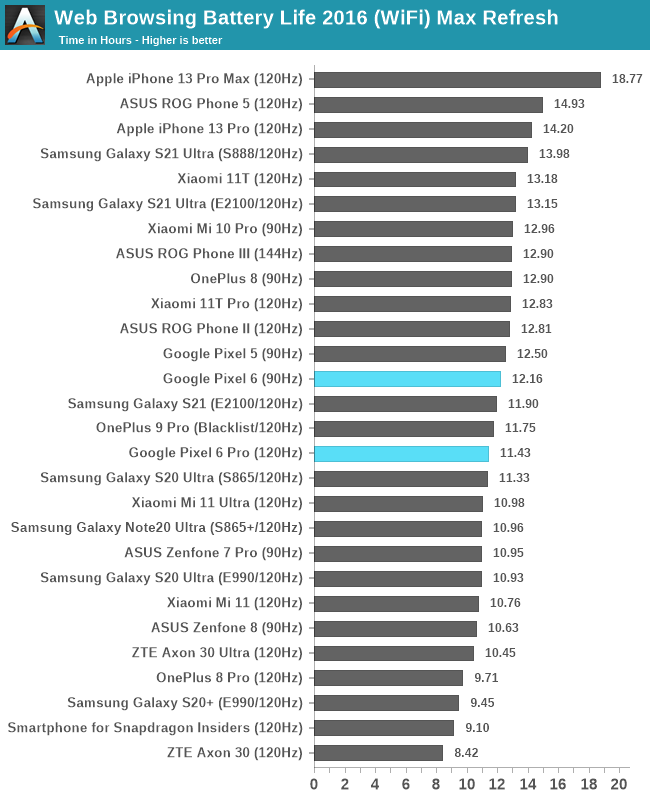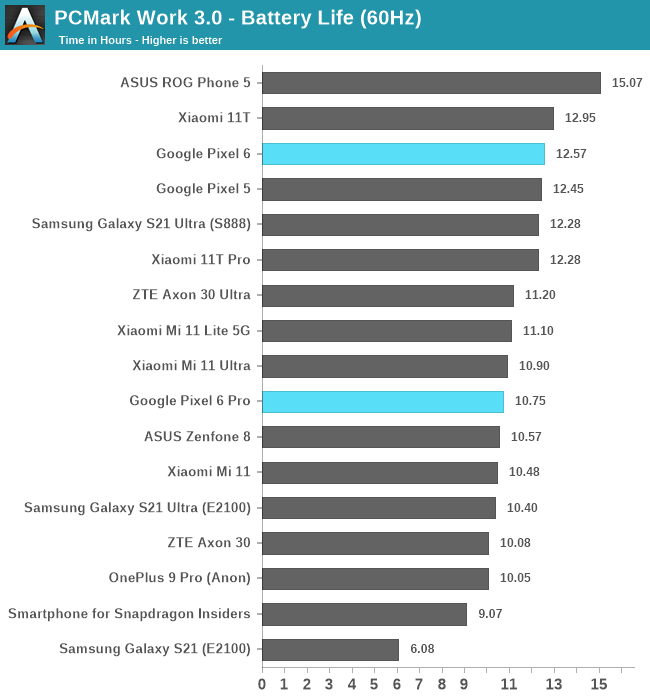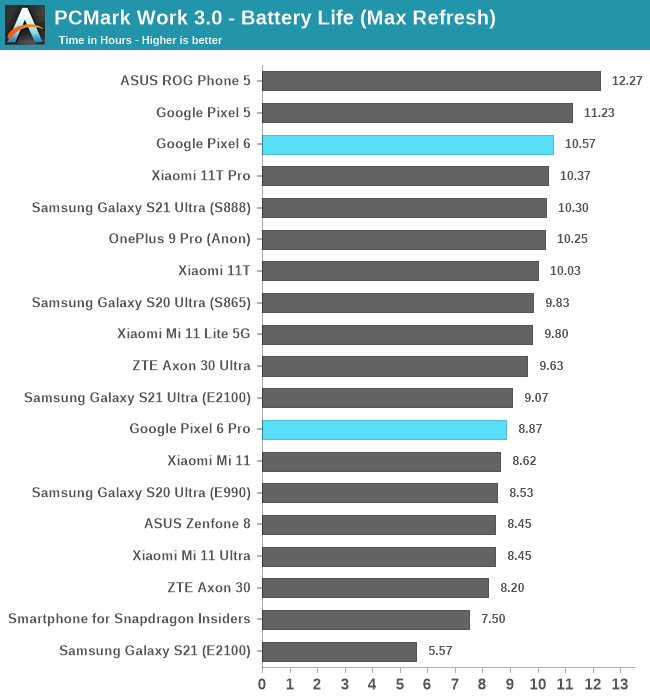Google's Tensor inside of Pixel 6, Pixel 6 Pro: A Look into Performance & Efficiency
by Andrei Frumusanu on November 2, 2021 8:00 AM EST- Posted in
- Mobile
- Smartphones
- SoCs
- Pixel 6
- Pixel 6 Pro
- Google Tensor
Phone Efficiency & Battery Life
While not directly released to the Google Tensor, I also finished running the various battery tests for the Pixel 6 and Pixel 6 Pro, and there are some remarks to be made in regards to the power efficiency of the devices, and how the new SoC ends up in relation to the competition.
As a reminder, the Pixel 6 comes with a 4614mAh battery and a 6.4” 1080p 90Hz OLED screen, while the Pixel 6 Pro features a 5003mAh battery and a 6.71” 1440p 120Hz OLED display, with variable refresh rate from 10-120Hz.

Starting off with the 60Hz web browsing results, both Pixel phones end up extremely similar in their longevity, at 14 hours runtime. The regular Pixel 6 is hard to compare things to as we don’t have too many recent phones with 90Hz displays in our results set, however the Pixel 6 Pro should be a direct comparison point to the S21 Ultras, as both feature 5000mAh batteries and similar display characteristics. The P6Pro here ends up slightly ahead of the Exynos 2100 S21 Ultra, which might not be too surprising given that the Tensor chip does end up at somewhat lower CPU power levels, even if performance is lower. It’s still quite behind the Snapdragon 888 variant of the S21 Ultra – which is again quite representative of the SoC efficiency differences.

Running the phones at their respective max refresh rates, both devices see larger drops, however the Pixel 6 Pro especially sees a more substantial hit. This time around, the 6 Pro ends up significantly behind the Exynos 2100 S21 Ultra, which had only a minor drop in the 60 -> 120Hz results.

Shifting over to PCMark at 60Hz, we see that there’s a larger difference in favour of the Pixel 6, as the Pixel 6 Pro ends up behind it in longevity by almost two hours. The 6 Pro still ends up in line with the E2100 S21U, however that device showcases significantly higher performance numbers in the test, which acts both as a performance metric for device responsivity as well as a battery life test.

At 120Hz, the 6 Pro ends up worse than the E2100 S21U, and quite worse than the S888 S21U.
When I was investigating the phones, the 6 Pro’s power behaviour was quite weird to me, as I saw best-case baseline power figures of around 640mW, and sometimes this inexplicably would also end up at 774mW or even higher. What this reminded me of, was the power behaviour of the OnePlus 9 Pro, which also suffered from extremely high baseline power figures. Both the 6 Pro and the 9 Pro advertise themselves as having LPTO OLED panels, but both of them very clearly do not behave the same as what we’ve seen on the Note20Ultra or the S21Ultra phones. The 6 Pro also only goes up to up to 750 nits 100% APL peak brightness in auto-brightness mode under bright ambient light, which is significantly lower than the S21U’s 942 nits. I think what’s happening here is that the Pixel 6 Pro simply doesn’t have the most state-of-the-art display, and thus is quite less efficient as what we find on the competition. It does kind of make sense for the price-point of the phone, but also explains some of the battery behaviour.
Naturally, the Tensor SoC also just doesn’t appear to be as efficient. Particularly many UI workloads would be run on the A76 cores of the chip, which just outright have a 30% perf/W disadvantage. The phone ends up OK in terms of absolute battery life, however performance metrics are lower than other devices.
I think the regular Pixel 6 here is just a much better device as it doesn’t seem to have any particular issues in display efficiency, even if it’s just a 1080 90Hz panel. There are naturally experience compromises, but it’s also a $599 phone, so the value here is very good.
US readers who are used to Qualcomm phones might also encounter efficiency regressions when under cellular data – we abandoned doing testing here many years ago due to the impossible task to get consistent test environments.










108 Comments
View All Comments
Alistair - Wednesday, November 3, 2021 - link
It's the opposite, the iPhone is massively ahead in performance, but every high end phone takes the same high end photos... you got the same photos but a lot less performance...aclos3 - Saturday, November 6, 2021 - link
I took some time to really test the camera and you are simply wrong. I have been photographing with it heavily for the last couple of days and the camera is incredible. Call it a gimmick or whatever, but the way they do their photo stacking puts this phone in a league of its own. If your main use case for a phone is benchmarking, I guess this is not your device.Lavkesh - Thursday, November 11, 2021 - link
Everyone and their grand mother do image stacking. iPhone is almost as good if not better even with a smaller sensor when compared to the latest Pixel. How's that for "in a league of its own"?Amandtec - Wednesday, November 3, 2021 - link
I don't doubt the veracity of your comment but I find the hostile undertone somewhat curious.damianrobertjones - Wednesday, November 3, 2021 - link
But... but... they said that it's amazing!! Who do I believe? /sZoolook - Saturday, November 6, 2021 - link
As long as they use Samsung process they will be hopelessly behind Apples Socs in efficiency unfortunately, would be interesting to see SD back on TSMC process for a direct comparison with Apple silicon.Tigran - Tuesday, November 2, 2021 - link
Performance looks very disappointing. Google promised 4.7x GPU performance improvement vs Pixel 5.singular9 - Tuesday, November 2, 2021 - link
I was enjoying how the speculation about the GS101 were claiming its "not far behind" the SD888. I was never expecting google to make another high end device, let alone one that undercuts most of the competition, as its just not what trends would say.I am not impressed. As someone who was rather hopeful that google would take control and bring us android users a true apple chip equivalent some day, this is definitely not the case with google silicon.
Considering how cookie cutter this design is, and how google made some major amateur decisions, I do not see google breaking away from the typical android SOC mold next generation.
Looking back at how long it took apple to design a near 100% solo design for the iPhone (A8X was the first A chip to use a complete inhouse GPU and etc design, other than ARM cores), that is a whopping 4 and a half years. Suppose this first google "designed" chip is following the same trend, an initial "brand name" break away yet still using a lot of help from other designs, and then slowly fixing one part at a time till its all fixed, while also improving what is already good, I could see google getting there by the Pixel X (10?). But as it stands, unless google dedicates a lot of time to actually altering Arm's own designs and simply having samsung make it, I don't see Tensor every surpassing qualcomm (unless samsung has some big breakthrough in their own CPU/GPU IP which may or may not come with AMD's help).
As the chip stands today, its "passable", but not impressive. Considering Google can get android to run really well on a SD765G, this isn't at all surprising. The TPU seems like a nice touch, since honestly, focusing on voice is more important than on "raw" cpu performance or something. I have always been frustrated with speech to text not being "perfect" and constantly having to correct it manually and "working around" its limitations. As for my own experience with the 6 Pro, its bloody good.
Now to specifics.
The X1 chips do get hot, as does the 5G modem. I switched the device to LTE for now. I do get 5G at home and pretty much most places I go, and it is fast, its not something I need right now. I even had a call drop over 5G because I walked around a buildings corner. Not fun.
The A76 excuse I have heard floating around, is that it takes up less physical die space, by A LOT. And apparently, there was simply no room for an A77 or A78 because the TPU and GPU took up so much room. I don't understand this compromise, when the GPU performance is this mediocre. Why not simply use the same GPU size as the S21 (Ex2100) and give the A78's more room? Don't know, but an odd choice for sure.
The A55 efficiency issues are noticeable. Try playing spotify over bluetooth for an hour, and watch the battery drain. I get consistently great standby time, and very good battery life when heavily using my device, but its these background screen off tasks that really chug the battery more than expected.
Over all though I haven't noticed any serious issues with my unit. The finger print scanner works as intended, and is better than my 8T. The camera does just as well if not better than the previous pixels. And over all...no complaints. But I wonder how much of this UX comes from google literally brute forcing their way with 2 X1 cores and a overkill GPU, and how much of it is them actually trying.
As for recommendations to google for Tensor V2, they need to not compromise efficiency for performance. This phone isn't designed to game, cut the GPU down, or heck, partner with AMD (who is working with samsung) to bring competitive graphics to mobile to compete with Adreno from QComm. 2 X1 cores, if necessary, can stay, but at that point, might as well just have 4 of them and get rid of all the other cores entirely and simply build a very good kernel to modulate the frequency. Or make it a 2+6 design with A57 cores. As someone who codes kernels for pixels and nexus devices for a long time, trying to optimize the software to really get efficiency out of the big.LITTLE system is near impossible, and in my opinion, worthless unless your entire scheduler is "screen on/off" based, which is literally BS. I doubt google has any idea how to build a good CPU governor nor scheduler to truly make this X+X+X system even work properly, since I have yet see qcomm or samsung do it "well" to call commendable.
The rest of the phone is fine. YoY improvements are always welcome, but I think the pixel 6/pro just really show how current mobile chips are so far behind apple that you might as well give up. YoY improvements have imo halted, and honestly no one seems to be having the thought that maybe we should cut power consumption in half WITHOUT increasing performance. I mean...the phones are fast enough.
Who knows. We will see next year.
PS: I also am curious what google will do with the Pixel 6A (if they make one at all). Will it use a cut down GS101 or will it get the whole chip? It would seem overkill to shove this into a 399$ phone. Wonder what cut downs will be made, or if there will be improvements as well.
sharath.naik - Tuesday, November 2, 2021 - link
Good thoughts, there is one big issue you missed. Pixel camera sensors 50mp/48mp being binned to 12mp yet Google labeled them as 50mp/48mp. Every shot outside the native 1x,4x is just a crop of the 12mp image including pottaitk3mp crop) and 10x(2.5mp crop}.teldar - Thursday, November 4, 2021 - link
You are absolutely a clueless troll and should go back to your cave. Your stupidity is unwanted.